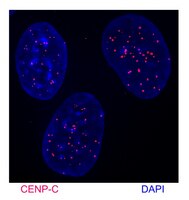ABE1957 Sigma-AldrichAnti-CENP-C Antibody
Anti-CENP-C Antibody, Cat. No. ABE1957, is a highly specific rabbit polyclonal antibody that targets CENP-C and has been tested in Immunocytochemistry and Western Blotting.
More>> Anti-CENP-C Antibody, Cat. No. ABE1957, is a highly specific rabbit polyclonal antibody that targets CENP-C and has been tested in Immunocytochemistry and Western Blotting. Less<<Anti-CENP-C Antibody MSDS (material safety data sheet) or SDS, CoA and CoQ, dossiers, brochures and other available documents.
Recommended Products
概述
| Replacement Information |
|---|
重要规格表
| Species Reactivity | Key Applications | Host | Format | Antibody Type |
|---|---|---|---|---|
| H | WB, ICC | Rb | Serum | Polyclonal Antibody |
| References |
|---|
| Product Information | |
|---|---|
| Format | Serum |
| Presentation | Rabbit polyclonal antibody serum with 0.05% sodium azide. |
| Quality Level | MQ100 |
| Physicochemical Information |
|---|
| Dimensions |
|---|
| Materials Information |
|---|
| Toxicological Information |
|---|
| Safety Information according to GHS |
|---|
| Safety Information |
|---|
| Packaging Information | |
|---|---|
| Material Size | 100 µL |
| Transport Information |
|---|
| Supplemental Information |
|---|
| Specifications |
|---|
| Global Trade Item Number | |
|---|---|
| 产品目录编号 | GTIN |
| ABE1957 | 04054839090103 |
Documentation
Anti-CENP-C Antibody MSDS
| 职位 |
|---|
Anti-CENP-C Antibody 分析证书
| 标题 | 批号 |
|---|---|
| Anti-CENP-C - 3484039 | 3484039 |
| Anti-CENP-C - 3862603 | 3862603 |
| Anti-CENP-C - 3911618 | 3911618 |
| Anti-CENP-C - 4051803 | 4051803 |
| Anti-CENP-C - 4176610 | 4176610 |
| Anti-CENP-C -Q2774374 | Q2774374 |








